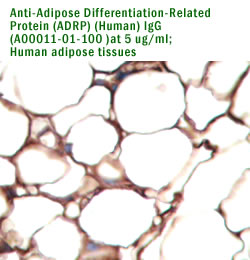
 |
| Home |
| New Products |
| Contact us |
Adipocyte Differentiation-Related Protein (ADRP)
Swiss-Prot entry Q99541; ADRP is the
major lipid droplet protein. May be involved in development and
maintenance of adipose tissue. Human ADRP, 437 amino acids, MW 48074
Da |
ADRP/ADFP, the major lipid droplet protein, is capable of sequestering TG in the cytosol, diverting it from entering into ER lumen for VLDL secretion. ADFP is involved in LD formation and/or maturation. Macrophages play an important role in atherosclerosis. An earlyevent in atherosclerosis is the accumulation of LDs in lesionalmacrophages associated with ADFP accumulation. ADFP is the most abundant LD-associated protein found in these cells. Modified lipoproteins, e.g., oxidized LDL or acetylated LDL, that arehighly atherogenic upregulate Adfp expression in macrophagesin vitro . Furthermore, Adfp mRNA is upregulated in human atherosclerotic plaques compared with lesion-free areas of thesame arteries . Conversely, ADFP overexpression in THP-1macrophage enhances lipid accumulation and prevents lipid efflux.These results suggest that ADFP is potentially a proatherosclerogenic protein. Our preliminary study using Adfp-deficient mice seems to support this notion. ADFP is the predominant LD-associated protein in skeletal musclein humans . Furthermore, muscle ADFP is lower in insulin-resistant subjects, a situation that can be reversed by weight reduction or by troglitazone treatment coincident with an improvement in glucose tolerance. It is possible that the upregulation of ADFP may help sequester fatty acids as TG in LDs, protecting the muscle from the detrimental effects of fatty acids on insulinaction and glucose homeostasis . Chang BHJ et al. Am J Physiol Gastrointest Liver Physiol 292: G1465-G1468, 2007 |
 |
 |
|
| Name | Code No. |
Size |
Price |
| Human Adipocyte Differentiation-Related Protein (ADRP) , recombinant | 00011-01-10 |
10 ug |
50.00 |
| Human Adipocyte Differentiation-Related Protein (ADRP) , recombinant | 00011-01-50 |
50 ug |
160.00 |
| Human Adipocyte Differentiation-Related Protein (ADRP) , recombinant | 100 ug |
300.00 |
|
| Human Adipocyte Differentiation-Related Protein (ADRP) , recombinant | 00011-01-1000 |
1 m g |
inquire |
| Anti Human Adipocyte Differentiation-Related Protein (ADRP) ,IgG | 100 ug |
200.00 |